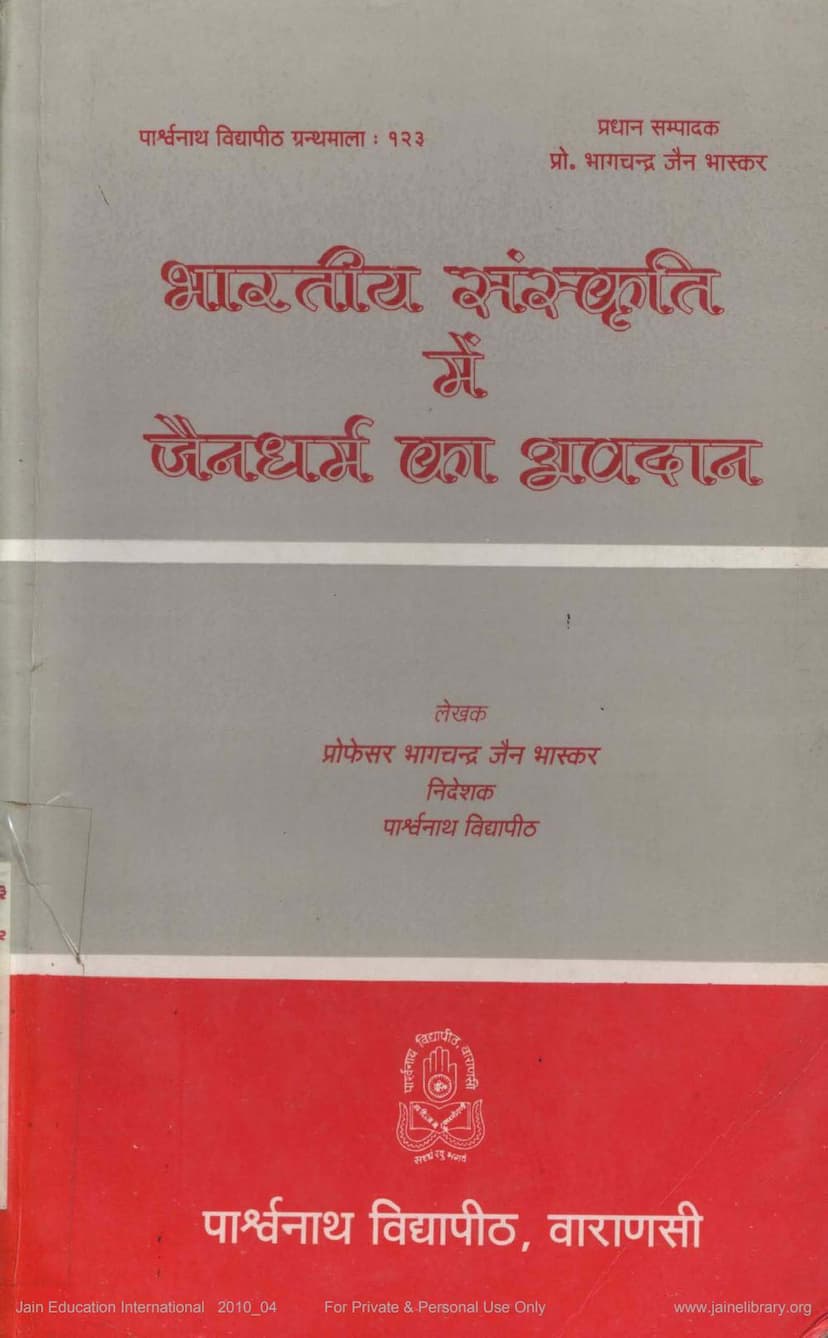Bharatiya Sanskruti Me Jain Dharma Ka Aavdan
Added to library: September 1, 2025

Summary
Here's a comprehensive summary of the Jain text "Bharatiya Sanskruti me Jain Dharma ka Avadan" by Bhagchandra Jain Bhaskar, based on the provided pages:
This book, "The Contribution of Jainism to Indian Culture," authored by Professor Bhagchandra Jain Bhaskar, Director of Parshvanath Shodhpith, Varanasi, and published by Parshvanath Shodhpith, is part of the Parshvanath Vidyapeeth Granthamala series. It explores the profound and multifaceted impact of Jainism on various aspects of Indian culture.
The book emphasizes that Jainism, perhaps the oldest religion in India, is founded on pure humanism, offering the unparalleled message of Ahimsa (non-violence) and Aparigraha (non-possession). It highlights Jainism's role in dismantling societal barriers of caste and class by establishing principles like Samata (equanimity), Atmapurushartha (self-effort), Sarvodaya (upliftment of all), Karmavada (law of karma), and Atmavatanya (self-liberation). The text asserts that Jainism has not only influenced ethical and spiritual thought but has also significantly enriched literature, art, and architecture.
Key Contributions of Jainism to Indian Culture are categorized as follows:
1. Cultural Contributions:
- Jain Culture and Spirituality: Culture is seen as an intrinsic element of individual and societal spiritual refinement, while civilization is its external, changing aspect. Jain culture encompasses individual conduct, values, ethics, religion, literature, art, education, and philosophy.
- Ahimsa and Aparigraha: These are presented as the foundational pillars of Jain culture.
- Atman is Paramatman (The Soul is the Supreme Soul): Jainism posits that the soul, through self-effort and the destruction of karma, can achieve the state of Paramatman. It emphasizes self-reliance and the inherent divinity within every soul, rejecting the need for an external creator deity.
- Self-Liberation (Atmavatanya): Jainism champions individual freedom, advocating for self-thinking and meditation, free from external divine control. Individuals are responsible for their actions and their consequences.
- Samata (Equanimity): This is a core tenet, emphasizing a balanced perspective and freedom from biases. It's described as the essence of humanity, opposing barbarism and narrow-mindedness.
- Character Purity (Charitrik Vishuddhi): This is achieved through the integrated practice of Samyagdarshan (right faith), Samyagjnana (right knowledge), and Samyakcharitra (right conduct), collectively known as the Ratnatraya (Three Jewels).
- Anekantavada (Non-absolutism/Multi-sidedness): This philosophical principle is crucial for promoting human unity, coexistence, equality, and Sarvodaya. It challenges absolutist viewpoints and advocates for understanding issues from multiple perspectives, fostering tolerance and dialogue.
- Social Equality: Jainism championed social equality, emphasizing karma over birth. Lord Mahavir reformed the caste system, advocating for equality based on conduct and character, and granting equal rights to women, including the path to liberation.
- Jainism and Shraman Culture: The book discusses the parallel development and influence of Shraman (ascetic) and Brahmin (Vedic) traditions in Indian culture. It highlights the Shraman tradition's emphasis on equanimity, self-effort, and renunciation, which influenced the Brahmin tradition. Conversely, the Brahmin tradition's ritualistic elements also influenced Shramanism. Jainism is presented as the origin of the Shraman tradition, predating Buddhism.
- Contribution to National Unity: Jainism's principles of equanimity, non-violence, and mutual dependence ("Parsparopagraho Jeevanam") have fostered national integration and unity amidst diversity. Its opposition to divisive forces like casteism and religious fanaticism has been a significant contribution to Indian identity.
- Use of Vernacular Languages (Prakrit): Lord Mahavir and subsequent Jain acharyas utilized Prakrit, the language of the common people, for propagating their philosophy. This democratic approach to language enriched the literary landscape and made spiritual teachings accessible to the masses.
2. Literary Contributions:
- Prakrit Language and Literature: The book details the historical development of Prakrit as a common language and its extensive literary output, covering religious texts, grammar, poetry, drama, and commentaries.
- Jain Prakrit Literature: This vast body of work includes:
- Agam Literature: Comprising Anga (canonical texts) and Upanga (subsidiary texts), detailing Jain philosophy, ethics, cosmology, and history.
- Commentaries and Interpretations: Including Niryukti, Bhashya, Churni, and Teeka literature, which explained and elaborated on the Agamic texts.
- Karma and Siddhanta Literature: Focusing on the intricacies of karma, its effects, and the principles of Jain metaphysics.
- Achara Literature: Detailing the conduct and rules for monks and lay followers.
- Devotional and Ritualistic Literature: Including hymns, stotras, and texts related to worship and rituals.
- Narrative and Fictional Literature: A rich collection of stories, legends, and biographies used for religious instruction and moral guidance.
- Scholastic Literature: Works on grammar, lexicography, metrics, astronomy, and other branches of knowledge.
- Sanskrit Literature: Jain acharyas also contributed significantly to Sanskrit literature, producing important philosophical, theological, legal, and poetic works.
- Apabhramsa Literature: This transitional language played a crucial role in the development of modern Indian languages, and Jain writers made substantial contributions to this genre.
- Literature in Other Indian Languages: The book also highlights Jain literary contributions in Tamil, Telugu, Kannada, Marathi, Gujarati, Hindi, and other regional languages, showcasing the widespread influence of Jainism.
Overall, the book argues that Jainism's contributions to Indian culture are foundational and pervasive. Its emphasis on ethical conduct, philosophical depth, linguistic innovation, and artistic expression has left an indelible mark on the subcontinent. The author, Professor Bhagchandra Jain Bhaskar, meticulously details these contributions across various cultural and literary domains, presenting Jainism as a vital force in shaping India's spiritual, intellectual, and artistic heritage.